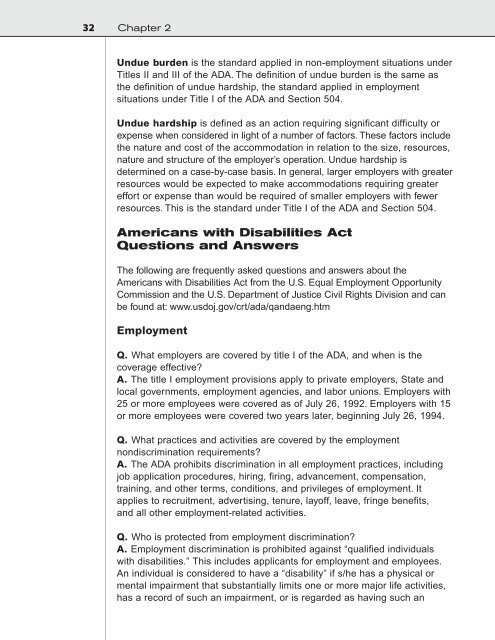Design for Accessibility: A Cultural Administrator's Handbook
Design for Accessibility: A Cultural Administrator's Handbook
Design for Accessibility: A Cultural Administrator's Handbook
You also want an ePaper? Increase the reach of your titles
YUMPU automatically turns print PDFs into web optimized ePapers that Google loves.
32 Chapter 2<br />
Undue burden is the standard applied in non-employment situations under<br />
Titles II and III of the ADA. The definition of undue burden is the same as<br />
the definition of undue hardship, the standard applied in employment<br />
situations under Title I of the ADA and Section 504.<br />
Undue hardship is defined as an action requiring significant difficulty or<br />
expense when considered in light of a number of factors. These factors include<br />
the nature and cost of the accommodation in relation to the size, resources,<br />
nature and structure of the employer’s operation. Undue hardship is<br />
determined on a case-by-case basis. In general, larger employers with greater<br />
resources would be expected to make accommodations requiring greater<br />
ef<strong>for</strong>t or expense than would be required of smaller employers with fewer<br />
resources. This is the standard under Title I of the ADA and Section 504.<br />
Americans with Disabilities Act<br />
Questions and Answers<br />
The following are frequently asked questions and answers about the<br />
Americans with Disabilities Act from the U.S. Equal Employment Opportunity<br />
Commission and the U.S. Department of Justice Civil Rights Division and can<br />
be found at: www.usdoj.gov/crt/ada/qandaeng.htm<br />
Employment<br />
Q. What employers are covered by title I of the ADA, and when is the<br />
coverage effective?<br />
A. The title I employment provisions apply to private employers, State and<br />
local governments, employment agencies, and labor unions. Employers with<br />
25 or more employees were covered as of July 26, 1992. Employers with 15<br />
or more employees were covered two years later, beginning July 26, 1994.<br />
Q. What practices and activities are covered by the employment<br />
nondiscrimination requirements?<br />
A. The ADA prohibits discrimination in all employment practices, including<br />
job application procedures, hiring, firing, advancement, compensation,<br />
training, and other terms, conditions, and privileges of employment. It<br />
applies to recruitment, advertising, tenure, layoff, leave, fringe benefits,<br />
and all other employment-related activities.<br />
Q. Who is protected from employment discrimination?<br />
A. Employment discrimination is prohibited against “qualified individuals<br />
with disabilities.” This includes applicants <strong>for</strong> employment and employees.<br />
An individual is considered to have a “disability” if s/he has a physical or<br />
mental impairment that substantially limits one or more major life activities,<br />
has a record of such an impairment, or is regarded as having such an


